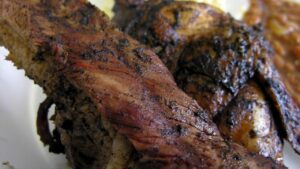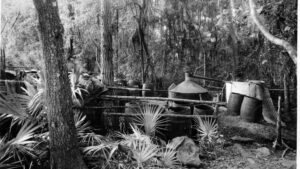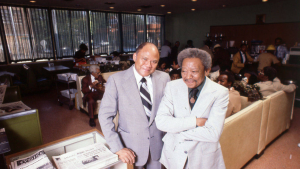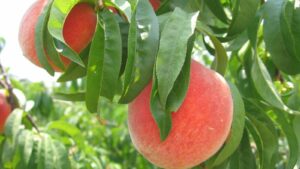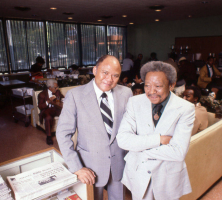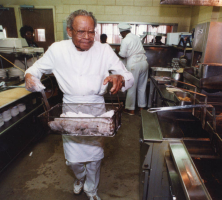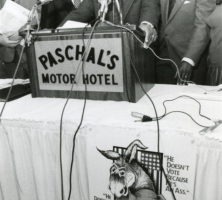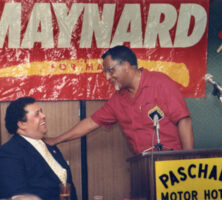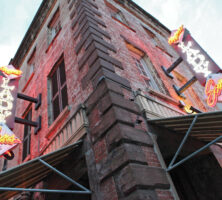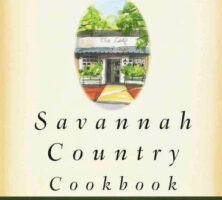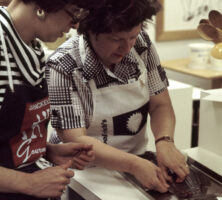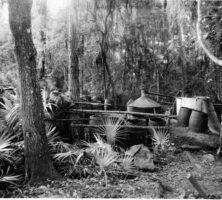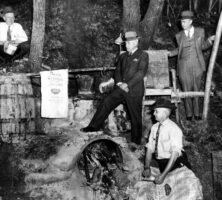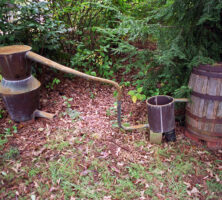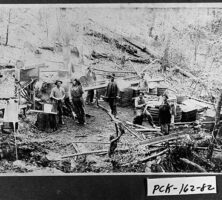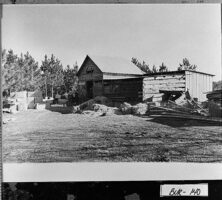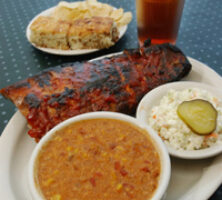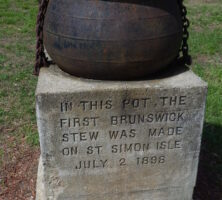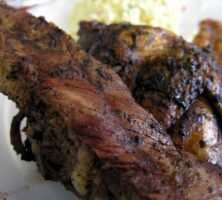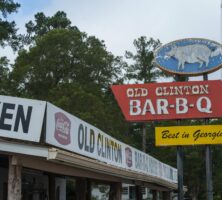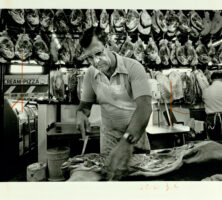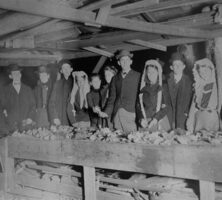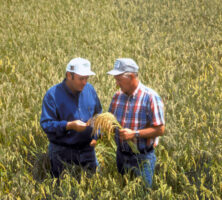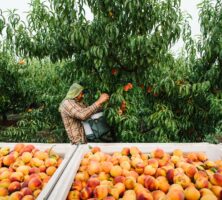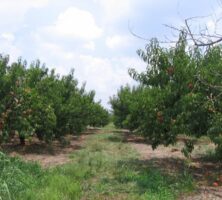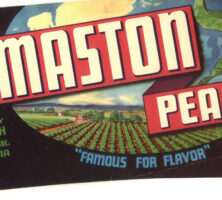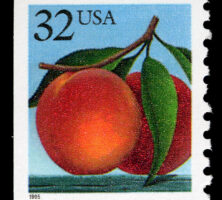The New Georgia Encyclopedia is supported by funding from A More Perfect Union, a special initiative of the National Endowment for the Humanities.
James and Robert Paschal opened Paschal Brothers Soda, a thirty-seat luncheonette at 837 West Hunter Street, in 1947. They are pictured here in 1978.
Courtesy of Special Collections & Archives, Georgia State University Library, Atlanta Journal-Constitution Photographic Archive.
The New Georgia Encyclopedia does not hold the copyright for this media resource and can neither grant nor deny permission to republish or reproduce the image online or in print. Requests for permission to publish or reproduce the resource should be submitted to Special Collections and Archives at Georgia State University.
In 1967 Paschal’s underwent a major expansion with the addition of a six-story, 120-room motel. Paschal’s Motor Hotel was the first Black-owned hotel in Atlanta.
Courtesy of Special Collections & Archives, Georgia State University Library, Atlanta Journal-Constitution Photographic Archive.
The New Georgia Encyclopedia does not hold the copyright for this media resource and can neither grant nor deny permission to republish or reproduce the image online or in print. Requests for permission to publish or reproduce the resource should be submitted to Special Collections and Archives at Georgia State University.
Robert Paschal prepares the restaurant's famous fried chicken, the recipe for which remains a secret to this day.
Courtesy of Special Collections & Archives, Georgia State University Library, Atlanta Journal-Constitution Photographic Archive.
The New Georgia Encyclopedia does not hold the copyright for this media resource and can neither grant nor deny permission to republish or reproduce the image online or in print. Requests for permission to publish or reproduce the resource should be submitted to Special Collections and Archives at Georgia State University.
Representative John Lewis speaks for Atlanta' Concerned Black Clergy at Paschal's Restaurant in 1988. The relationships that James and Robert Paschal built within the city’s Black community made Paschal’s a central meeting spot during the civil rights movement and helped earn the restaurant its reputation as Atlanta’s “Black City Hall.”
Courtesy of Special Collections & Archives, Georgia State University Library, Atlanta Journal-Constitution Photographic Archive.
The New Georgia Encyclopedia does not hold the copyright for this media resource and can neither grant nor deny permission to republish or reproduce the image online or in print. Requests for permission to publish or reproduce the resource should be submitted to Special Collections and Archives at Georgia State University.
Reverend Joseph E. Lowery (right) and mayoral candidate Maynard Jackson at a 1989 campaign event at Paschal's Motor Hotel. Paschal’s was a hotbed of political activity for Atlanta’s African American community.
Courtesy of Special Collections & Archives, Georgia State University Library, Atlanta Journal-Constitution Photographic Archive.
The New Georgia Encyclopedia does not hold the copyright for this media resource and can neither grant nor deny permission to republish or reproduce the image online or in print. Requests for permission to publish or reproduce the resource should be submitted to Special Collections and Archives at Georgia State University.
Albany native Paula Deen, a well-known restaurateur and television personality, is the host of Paula's Home Cooking, which premiered on the Food Network in 2002. Her restaurant, The Lady and Sons, is a popular tourist destination in Savannah.
Photograph from Paula Deen
The New Georgia Encyclopedia does not hold the copyright for this media resource and can neither grant nor deny permission to republish or reproduce the image online or in print. All requests for permission to publish or reproduce the resource must be submitted to the rights holder.
Paula Deen's iconic restaurant The Lady and Sons opened in downtown Savannah in 1996 and features such southern favorites as fried green tomatoes and hoecakes. In 2004 she opened another restaurant in Savannah, Uncle Bubba's Oyster House, with her younger brother.
Image from Steven Miller
The New Georgia Encyclopedia does not hold the copyright for this media resource and can neither grant nor deny permission to republish or reproduce the image online or in print. All requests for permission to publish or reproduce the resource must be submitted to the rights holder.
Paula Deen published her first cookbook, The Lady and Sons: Savannah Country Cookbook, in 1997, one year after opening The Lady and Sons restaurant in Savannah. She became well known outside the South by selling the cookbook on QVC, a home-shopping television network.
The New Georgia Encyclopedia does not hold the copyright for this media resource and can neither grant nor deny permission to republish or reproduce the image online or in print. All requests for permission to publish or reproduce the resource must be submitted to the rights holder.
Atlanta-based Alton Brown, the host and producer of the Food Network's television series Good Eats, has written numerous books about cooking, including I'm Just Here for the Food (2002) and Good Eats: The Early Years (2009).
The New Georgia Encyclopedia does not hold the copyright for this media resource and can neither grant nor deny permission to republish or reproduce the image online or in print. All requests for permission to publish or reproduce the resource must be submitted to the rights holder.
Alton Brown, raised in White County, is a food television personality and producer based in Atlanta. His cooking show, Good Eats, premiered in 1999 and received a George Foster Peabody Award from the University of Georgia in 2007.
Photograph from UGA Today
The New Georgia Encyclopedia does not hold the copyright for this media resource and can neither grant nor deny permission to republish or reproduce the image online or in print. All requests for permission to publish or reproduce the resource must be submitted to the rights holder.
Nathalie Dupree's practical sensibility and guileless approach to teaching have helped her cooking shows and books to gain wide popularity. Dupree has published nine cookbooks and appeared in more than 300 half-hour television episodes.
Photograph by Chris Rogers
The New Georgia Encyclopedia does not hold the copyright for this media resource and can neither grant nor deny permission to republish or reproduce the image online or in print. All requests for permission to publish or reproduce the resource must be submitted to the rights holder.
Nathalie Dupree (left) works with a student at her cooking school, which opened at Rich's Department Store in 1975. The school ran for almost ten years and enrolled more than 10,000 students.
Courtesy of Nathalie Dupree
The New Georgia Encyclopedia does not hold the copyright for this media resource and can neither grant nor deny permission to republish or reproduce the image online or in print. All requests for permission to publish or reproduce the resource must be submitted to the rights holder.
The New Georgia Encyclopedia does not hold the copyright for this media resource and can neither grant nor deny permission to republish or reproduce the image online or in print. All requests for permission to publish or reproduce the resource must be submitted to the rights holder.
Mull from Bill's Barbecue in Madison County has the consistency of oatmeal. This regional stew is usually made with chicken, but any meat, including squirrel, rabbit, or dove, can be used.
Photograph by Melinda S. Mullikin, New Georgia Encyclopedia
The New Georgia Encyclopedia does not hold the copyright for this media resource and can neither grant nor deny permission to republish or reproduce the image online or in print. All requests for permission to publish or reproduce the resource must be submitted to the rights holder.
A fence surrounds this still, located in a swamp in south Georgia, to keep cattle and hogs from consuming the mash.
Courtesy of Atlanta Journal-Constitution.
The New Georgia Encyclopedia does not hold the copyright for this media resource and can neither grant nor deny permission to republish or reproduce the image online or in print. All requests for permission to publish or reproduce the resource must be submitted to the Atlanta Journal-Constitution.
The New Georgia Encyclopedia does not hold the copyright for this media resource and can neither grant nor deny permission to republish or reproduce the image online or in print. All requests for permission to publish or reproduce the resource must be submitted to the rights holder.
During the Civil War the U.S. Congress created the Internal Revenue Service to collect taxes on liquor, tobacco, and other "luxuries." The production of moonshine was not in and of itself illegal, but attempts by producers to avoid paying the federal tax were. "Revenuers" were what moonshiners called the federal agents who sought to enforce the liquor law.
Courtesy of Atlanta Journal-Constitution.
The New Georgia Encyclopedia does not hold the copyright for this media resource and can neither grant nor deny permission to republish or reproduce the image online or in print. All requests for permission to publish or reproduce the resource must be submitted to the Atlanta Journal-Constitution.
This old still, once used for making "moonshine," belongs to a retired Cherokee County sheriff. The still is a remnant from the time when bootleggers were common in North Georgia.
Courtesy of Atlanta Journal-Constitution.
The New Georgia Encyclopedia does not hold the copyright for this media resource and can neither grant nor deny permission to republish or reproduce the image online or in print. All requests for permission to publish or reproduce the resource must be submitted to the Atlanta Journal-Constitution.
Men operating a moonshine still in Pickens County in the 1920s.
Courtesy of Georgia Archives, Vanishing Georgia, #pck162-82.
The New Georgia Encyclopedia does not hold the copyright for this media resource and can neither grant nor deny permission to republish or reproduce the image online or in print. Requests for permission to publish or reproduce the resource should be submitted to the Georgia Archives.
Burke County law enforcement officers and federal revenue agents gather in the shadow (left) of a barn that holds a moonshine still, 1960s.
Courtesy of Georgia Archives, Vanishing Georgia, #bur140.
The New Georgia Encyclopedia does not hold the copyright for this media resource and can neither grant nor deny permission to republish or reproduce the image online or in print. Requests for permission to publish or reproduce the resource should be submitted to the Georgia Archives.
Virtually any vegetable and seasoning can be added to the requisite meat, corn, and tomatoes, but onions, lima beans, and potatoes commonly make an appearance. The stew is often served with barbecue, coleslaw, corn bread, and iced tea.
Courtesy of Atlanta Journal-Constitution.
The New Georgia Encyclopedia does not hold the copyright for this media resource and can neither grant nor deny permission to republish or reproduce the image online or in print. All requests for permission to publish or reproduce the resource must be submitted to the Atlanta Journal-Constitution.
A twenty-five-gallon iron pot outside the coastal town of Brunswick, Georgia, bears a plaque declaring it to be the vessel in which this favorite southern food was first cooked in 1898.
Image from BEV Norton
The New Georgia Encyclopedia does not hold the copyright for this media resource and can neither grant nor deny permission to republish or reproduce the image online or in print. All requests for permission to publish or reproduce the resource must be submitted to the rights holder.
Many types of meat are barbecued, ranging from beef and whole hogs to chicken and, along the coast, fish and shellfish. Pork—primarily ribs, shoulders, and hams—is the meat of choice for Georgia barbecues.
Photograph by Judy Baxter
The New Georgia Encyclopedia does not hold the copyright for this media resource and can neither grant nor deny permission to republish or reproduce the image online or in print. All requests for permission to publish or reproduce the resource must be submitted to the rights holder.
The New Georgia Encyclopedia does not hold the copyright for this media resource and can neither grant nor deny permission to republish or reproduce the image online or in print. All requests for permission to publish or reproduce the resource must be submitted to the rights holder.
The Old Clinton Barbecue House, located in Jones County in middle Georgia, has been serving barbecue since 1958.
Courtesy of Explore Georgia, Photograph by Geoff L. Johnson.
The New Georgia Encyclopedia does not hold the copyright for this media resource and can neither grant nor deny permission to republish or reproduce the image online or in print. Requests for permission to publish or reproduce the resource may need to be submitted to Explore Georgia.
The New Georgia Encyclopedia does not hold the copyright for this media resource and can neither grant nor deny permission to republish or reproduce the image online or in print. All requests for permission to publish or reproduce the resource must be submitted to the rights holder.
The New Georgia Encyclopedia does not hold the copyright for this media resource and can neither grant nor deny permission to republish or reproduce the image online or in print. All requests for permission to publish or reproduce the resource must be submitted to the rights holder.
If the 'king' of the antebellum southern economy were cotton, geographer Sam Bowers Hilliard writes in Hog Meat and Hoecake, "then the title of 'queen' must go to the pig."
Courtesy of Special Collections & Archives, Georgia State University Library, Atlanta Journal-Constitution Photographic Archive.
The New Georgia Encyclopedia does not hold the copyright for this media resource and can neither grant nor deny permission to republish or reproduce the image online or in print. Requests for permission to publish or reproduce the resource should be submitted to Special Collections and Archives at Georgia State University.
The New Georgia Encyclopedia does not hold the copyright for this media resource and can neither grant nor deny permission to republish or reproduce the image online or in print. All requests for permission to publish or reproduce the resource must be submitted to the rights holder.
The New Georgia Encyclopedia does not hold the copyright for this media resource and can neither grant nor deny permission to republish or reproduce the image online or in print. All requests for permission to publish or reproduce the resource must be submitted to the rights holder.
An oyster roast in St. Marys, pictured in the 1890s. Oyster roasts have long made for a popular, festive occasion during the fall and winter months along the Georgia coast.
Courtesy of Georgia Archives, Vanishing Georgia, # cam068.
The New Georgia Encyclopedia does not hold the copyright for this media resource and can neither grant nor deny permission to republish or reproduce the image online or in print. Requests for permission to publish or reproduce the resource should be submitted to the Georgia Archives.
Prized for their sweetness, Vidalia onions get their name from the Toombs County town where farmer Mose Coleman first marketed them in the 1930s.
Image from UGA CAES/Extension
The New Georgia Encyclopedia does not hold the copyright for this media resource and can neither grant nor deny permission to republish or reproduce the image online or in print. All requests for permission to publish or reproduce the resource must be submitted to the rights holder.
The Elberta peach variety, which flourishes along the state's fall line, spurred Georgia peach production, and by the early 1900s Georgia was the leading peach grower in the nation.
Photo by AbbydonKrafts
The New Georgia Encyclopedia does not hold the copyright for this media resource and can neither grant nor deny permission to republish or reproduce the image online or in print. All requests for permission to publish or reproduce the resource must be submitted to the rights holder.
The New Georgia Encyclopedia does not hold the copyright for this media resource and can neither grant nor deny permission to republish or reproduce the image online or in print. All requests for permission to publish or reproduce the resource must be submitted to the rights holder.
The New Georgia Encyclopedia does not hold the copyright for this media resource and can neither grant nor deny permission to republish or reproduce the image online or in print. All requests for permission to publish or reproduce the resource must be submitted to the rights holder.
The New Georgia Encyclopedia does not hold the copyright for this media resource and can neither grant nor deny permission to republish or reproduce the image online or in print. All requests for permission to publish or reproduce the resource must be submitted to the rights holder.
Dexter Weaver, owner of Athens eatery Weaver D's, explains that is food for the soul.
Video by Darby Carl Sanders, New Georgia Encyclopedia
The New Georgia Encyclopedia does not hold the copyright for this media resource and can neither grant nor deny permission to republish or reproduce the image online or in print. All requests for permission to publish or reproduce the resource must be submitted to the rights holder.
Dexter Weaver, owner of the Athens soul food eatery Weaver D's, explains how he cooks his collards, a southern soul food staple.
Video by Darby Carl Sanders, New Georgia Encyclopedia
The New Georgia Encyclopedia does not hold the copyright for this media resource and can neither grant nor deny permission to republish or reproduce the image online or in print. All requests for permission to publish or reproduce the resource must be submitted to the rights holder.
The New Georgia Encyclopedia does not hold the copyright for this media resource and can neither grant nor deny permission to republish or reproduce the image online or in print. All requests for permission to publish or reproduce the resource must be submitted to the rights holder.
The New Georgia Encyclopedia does not hold the copyright for this media resource and can neither grant nor deny permission to republish or reproduce the image online or in print. All requests for permission to publish or reproduce the resource must be submitted to the rights holder.
Despite its huge importance to Georgia's economy, the rice industry was subject to relatively rigid geographical/environmental constraints, and it never utilized more than a small proportion of the available land in the Lowcountry, much less in Georgia as a whole. Even at its peak no more than 45,000 acres of land were devoted directly to rice production in Georgia.
Photograph by U.S. Department of Agriculture
The New Georgia Encyclopedia does not hold the copyright for this media resource and can neither grant nor deny permission to republish or reproduce the image online or in print. All requests for permission to publish or reproduce the resource must be submitted to the rights holder.
The New Georgia Encyclopedia does not hold the copyright for this media resource and can neither grant nor deny permission to republish or reproduce the image online or in print. All requests for permission to publish or reproduce the resource must be submitted to the rights holder.
Harvesting peaches in Peach County, the self-proclaimed "Peach Capital of the World."
Courtesy of Explore Georgia, Photograph by Andrew Thomas Lee.
The New Georgia Encyclopedia does not hold the copyright for this media resource and can neither grant nor deny permission to republish or reproduce the image online or in print. Requests for permission to publish or reproduce the resource may need to be submitted to Explore Georgia.
Peaches all but vanished in Upson County with the onset of the Great Depression as laborers entered work in the mills rather than working in the orchards. Peach orchards were cut down in favor of the timber industry.
Courtesy of Thomaston-Upson Archives
The New Georgia Encyclopedia does not hold the copyright for this media resource and can neither grant nor deny permission to republish or reproduce the image online or in print. All requests for permission to publish or reproduce the resource must be submitted to the rights holder.
More than 80 percent of Georgia's commercial peach crop is grown in the central part of the state. The fruit is usually available from mid-May until August.
Photograph by Chris Fannin
The New Georgia Encyclopedia does not hold the copyright for this media resource and can neither grant nor deny permission to republish or reproduce the image online or in print. All requests for permission to publish or reproduce the resource must be submitted to the rights holder.
In the 1920s the peach industry thrived in Upson County. At the turn of the twenty-first century Georgia's peach industry is concentrated in Crawford, Peach, Taylor, and Macon counties.
Courtesy of Thomaston-Upson Archives
The New Georgia Encyclopedia does not hold the copyright for this media resource and can neither grant nor deny permission to republish or reproduce the image online or in print. All requests for permission to publish or reproduce the resource must be submitted to the rights holder.
The peach, depicted on this 1995 U.S. postage stamp, is Georgia's official state fruit.
Courtesy of Smithsonian National Postal Museum
The New Georgia Encyclopedia does not hold the copyright for this media resource and can neither grant nor deny permission to republish or reproduce the image online or in print. All requests for permission to publish or reproduce the resource must be submitted to the rights holder.
